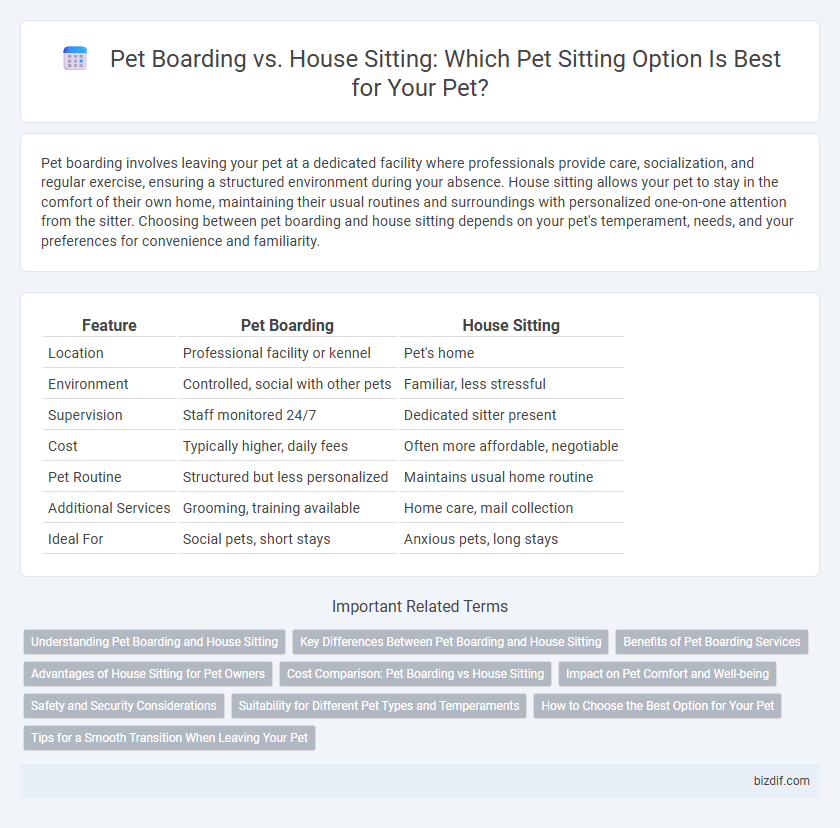Pet boarding involves leaving your pet at a dedicated facility where professionals provide care, socialization, and regular exercise, ensuring a structured environment during your absence. House sitting allows your pet to stay in the comfort of their own home, maintaining their usual routines and surroundings with personalized one-on-one attention from the sitter. Choosing between pet boarding and house sitting depends on your pet's temperament, needs, and your preferences for convenience and familiarity.
Table of Comparison
| Feature | Pet Boarding | House Sitting |
|---|---|---|
| Location | Professional facility or kennel | Pet's home |
| Environment | Controlled, social with other pets | Familiar, less stressful |
| Supervision | Staff monitored 24/7 | Dedicated sitter present |
| Cost | Typically higher, daily fees | Often more affordable, negotiable |
| Pet Routine | Structured but less personalized | Maintains usual home routine |
| Additional Services | Grooming, training available | Home care, mail collection |
| Ideal For | Social pets, short stays | Anxious pets, long stays |
Understanding Pet Boarding and House Sitting
Pet boarding involves leaving pets at a specialized facility where they receive professional care, socialization, and monitoring, often suitable for pets needing regular supervision or medical attention. House sitting provides personalized care in the pet's home environment, minimizing stress and maintaining routine, ideal for animals with anxiety or special needs. Both options ensure pet well-being, but choosing between pet boarding and house sitting depends on the pet's temperament, health requirements, and owner preferences.
Key Differences Between Pet Boarding and House Sitting
Pet boarding involves placing pets in a dedicated facility where they receive professional care, socialization, and regular monitoring, while house sitting entails a sitter staying in the owner's home to provide personalized care and maintain the pet's familiar environment. Key differences include the level of personalized attention, with house sitting offering one-on-one care in the pet's own space, whereas pet boarding often includes interaction with other animals in a communal setting. Costs also vary, as pet boarding typically charges daily rates for facilities and group care, while house sitting services may include extended stays and additional home maintenance duties.
Benefits of Pet Boarding Services
Pet boarding services provide a structured environment with professional care, ensuring pets receive regular feeding, exercise, and socialization. Veterinary support and emergency protocols are often available on-site, enhancing pet safety while owners are away. Facilities offer tailored activities and supervision, reducing stress and promoting well-being compared to house sitting.
Advantages of House Sitting for Pet Owners
House sitting offers pet owners personalized care as pets remain in their familiar environment, reducing stress and anxiety often caused by relocation. It ensures consistent daily routines and attention, promoting better health and comfort for pets. Furthermore, house sitting provides security for the home, deterring potential threats while owners are away.
Cost Comparison: Pet Boarding vs House Sitting
Pet boarding typically costs between $25 and $85 per night, depending on the facility and services offered, while house sitting often ranges from $30 to $60 per day or may be arranged in exchange for free accommodation. Boarding facilities may charge extra for special care like administering medication or extended playtime, whereas house sitters usually include these services in their fees, which can make house sitting more cost-effective for long-term pet care. Evaluating these options depends on the pet's needs and the owner's budget, with house sitting often providing more personalized care at a comparable or lower cost.
Impact on Pet Comfort and Well-being
Pet boarding facilities provide professional care and social interaction but may cause stress due to unfamiliar environments and noise. House sitting allows pets to remain in their home environment, maintaining routine and reducing anxiety, which supports better mental and emotional well-being. Choosing house sitting often results in greater comfort and stability for pets during owners' absences.
Safety and Security Considerations
Pet boarding facilities often have professional staff and secure environments designed to minimize risks, with surveillance cameras, secure enclosures, and regular health checks ensuring pet safety. House sitting typically provides a more familiar and less stressful environment for pets, reducing anxiety and exposure to contagious diseases, while a trusted sitter maintains home security by monitoring entry points and maintaining routine household activities. Evaluating the safety and security aspects of both options depends on the pet's temperament, health needs, and the homeowner's preference for on-site supervision versus specialized care.
Suitability for Different Pet Types and Temperaments
Pet boarding facilities provide structured environments ideal for social and adaptable pets comfortable with new surroundings and other animals. House sitting offers a familiar home setting best suited for anxious, elderly, or special-needs pets requiring individualized care and consistency. Selecting between pet boarding and house sitting depends on the pet's temperament, health conditions, and preference for either social interaction or comfort in a known environment.
How to Choose the Best Option for Your Pet
When deciding between pet boarding and house sitting, consider your pet's temperament, health needs, and comfort level with new environments. Pet boarding facilities offer structured care and socialization opportunities, ideal for pets that enjoy interaction and supervision by professionals. House sitting provides personalized attention in your pet's familiar surroundings, reducing stress for animals anxious about change or separation.
Tips for a Smooth Transition When Leaving Your Pet
Choose pet boarding facilities with experienced caregivers and clean environments to ensure your pet's safety and comfort during your absence. For house sitting, select a trusted sitter who can maintain your pet's daily routines and provide personalized attention in a familiar setting. Prepare detailed instructions about your pet's diet, exercise, and medical needs to facilitate a seamless transition and reduce your pet's anxiety.
Pet boarding vs House sitting Infographic

 bizdif.com
bizdif.com